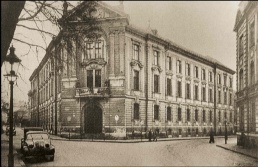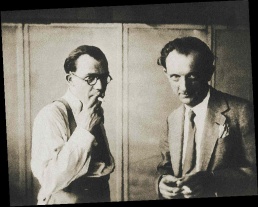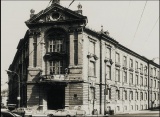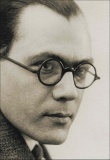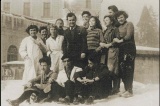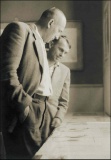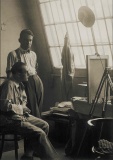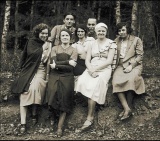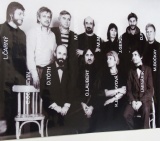School of Arts and Crafts, Bratislava
In 1920, Josef Vydra, founded the Society of Art Industry orientated towards the production and promotion of modern design. The Society intended to organise production workshops and enterprises, but the generally low level of Slovak industry resulted in it being dissolved in 1924. Josef Vydra later concentrated on educational activities. In 1928 on his initiative the School of Arts and Crafts [Škola umeleckých remesiel] (1928-1939) was founded in Bratislava with support from the Chamber of Commerce and Industry to provide evening courses in drawing and advertising. Later there were departments for textiles, metal, wood, ceramics, photography, typography, decorative painting and window-dressing. It quickly became one of the most progressive educational institutions in the area of utility creative art disciplines in Europe during the interwar period. Study in specialized departments was preceded by preliminary basic elementary courses in drawing, surface and space composition, colour harmony, modelling and lettering. In reality, this already involved an application of the Bauhaus method. The school's intention was also to integrate national folk craft traditions into modern production. The teachers included avant-garde artists Ľudovít Fulla, Mikuláš Galanda, Jaromír Funke and lecturers such as Moholy-Nagy, Tschichold, Kállai, Hannes Meyer and others. They drew their inspiration from Analytical Realism, Constructivism and the poetic fantasy of children's art - combining all these influences with a high level of craft skills and with folk art traditions going back over hundreds of years. In mid-1930s the school was attended by 200 students and the teaching staff counted some twenty members. The students were of Slovak, Czech, German and Hungarian nationalities and, in time, they also came from Poland, Yugoslavia, Germany and Bulgaria. After Czech professors were forced to leave Slovakia, Vydra persuaded Fulla to take up the direction of the School after him in the hope that continuity would thus be preserved. It was for a very short time only-ten months. In October 1939 the School of Applied Arts was closed. [1] [2]
- Photography
- Jaromír Funke, Czech photographer. In 1922, he set out on the road to abstraction, ultimately developing a school of his own: Photogenism. He responded to the inspiration of Cubism and also made exemplary works in the styles of New Objectivity and Constructivism. In the 1920s, he became one of the first photographers to accept Poetism and Surrealism. With the exception of Jaroslav Rössler, Funke was the only important Czechoslovak photographer to grasp the international context of avant-garde photography, painting, and sculpture. Not only with his photographs but also with his extensive work as a theorist, critic, organizer, editor, and, in particular, as a teacher, he considerably influenced the photography of his day. At art schools in Bratislava (head of photography department at the School of Arts and Crafts since 1931; he considered studying at the Bauhaus, but in the end gave priority to teaching in Bratislava) and Prague he had a unique opportunity to disseminate his knowledge at a time when this was impossible in the neighbouring countries, particularly Nazi Germany. Editor of the Fotografický obzor [Photographic Horizons] journal.
- Irena Blühová, photographer. Studied under Peterhans at Bauhaus (1931-33) and later at Plicka's film school in Bratislava. Organizer of the movement of social photography in Bratislava. (more, more)
- Typography
- Zdeněk Rossmann. Czech architect, graphic designer, scenographer, photographer and teacher at the School of Arts and Crafts in Bratislava (1932-1938) and Brno (1939-1943). Member of Devětsil in Brno. Studied at Bauhaus in Dessau (along with his wife Marie Rossmannová, a photographer). Designed the magazines Pásmo, Disk, Index, Slovenská grafia and nová bratislava. Lived in Bratislava from 1931. Published a book on the use of typography and photography in advertising, Písmo a fotografie v reklamě (Index, Olomouc), in 1938.
- Architecture
- Painting and graphic art
- Ľudovít Fulla, painter. Studied in Prague. Applied constructive typography and graphic design in jacket designs (books and magazines), and a journal 'Slovenská grafika'. [3]
- Mikuláš Galanda, painter, graphic designer. Studied in Prague. [4] [5]
- Theatre
- Frantisek Tröster, scenographer. Head of metal-working department at the School (1934-38). He had worked on Le Corbusier's project for a new quarter in Algiers. [6]
- Film
- Karol Plicka. Came during the last years of the School's existence. Later in 1938 in Bratislava he opened the first film school in Czechoslovakia.
- Applied arts
- Júlia Horová, ceramics artist.
Images
See also
Literature
- Francis A. Taylor, article on his impressions of a visit to the Bratislava School, Journal of the Royal Society of Arts, no. 4332, 1935; "Současné školy umění a řemesel na kontinente" [Contemporary School of Arts and Crafts on the Continent], Výtvarná výchova, Prague, vol. 2, no. 3, 1936, pp. 11-29 (Czech).
- Tomáš Štrauss, "Slovenský variant moderny (ŠUR Bratislava 1928-1938)" [A Slovak Variant of Modernism]. Umění a remesla, 1978, no. 3, pp 10-19; "Die Slowakische Variante der Moderne", Bauhauskolloquium von 27. bis 29. Juni 1979 in Weimar, WissenschaftlicheZeitschriftder Hochschule Architektur und Bauwesen, Weimar, vol. 26, nos. 4-5, 1979, pp 405-13. [7]
- Fero Tomík, "J. Funke a ŠUR v Bratislave" [J. Funke and the School of Arts and Crafts in Bratislava]. In: Aktuálnost československé meziválečné fotografie. Dum umění města Brna, Brno 1979. pp 54-61.
- Maria Pötzl-Malikova, "Die Kunstgewerbeschule in Preßburg 1928-1939. Zur Ausstrahlung der Bauhaus-Ideen in der Slowakei", Vorträge der Tagungen des Collegium Carolinum Bad Wiesse vom 23. bis 25. November 1979 und vom 28. bis 30. November 1980, R. Oldenbourg Verlag, Munich/Vienna, 1982, pp 201-324.
- Iva Mojžišová, "Die personliche Beziehungen zwischen den Angehörigen des Bauhauses und der Kunstgewerbeschule in Bratislava in Lichte neuentdeckter Dokumente", 4. internationales Bauhauskolloquium vom 24. bis 25. Juni 1986, in Wissenschaftliche Zeitschrift der Hochschule fur Architektur Bauwesen Weimar, vol. 33, nos. 4-5-6, 1987, pp 335-8. [8]
- "Škola umeleckých remesiel v Bratislave a Bauhaus", Ars, Bratislava, 1990, pp 43-54
- "The First Wave of Avant-garde: Bratislava 1930", Niedzica Seminars VI. October 19-22, 1989, Association of Polish Art Historians, Cracow, 1991, pp 47-51
- Iva Mojžišová, "Avant-Garde Repercussions and the School of Applied Arts in Bratislava, 1928-1939", Journal of Design History, Vol. 5, No. 4 (1992), pp. 273-279. [9]
- Susanne Anna (ed.), Das Bauhaus im Osten: Slowakische und tschechische Avantgarde 1928-1939, Hatje Cantz Verlag, 1997. [10] contents, [11], review
- Alena Kavčáková, Josef Vydra (1884-1959) v kontextu umělecké a výtvarně pedagogické avantgardy 20. století: historie a současnost univerzitního výtvarného vzdělávání v Olomouci, Univerzita Palackého v Olomouci, 2010, 239 pages. ISBN 8024425866, 9788024425863. Contents. [12]
